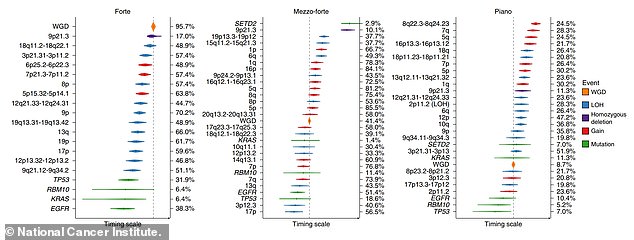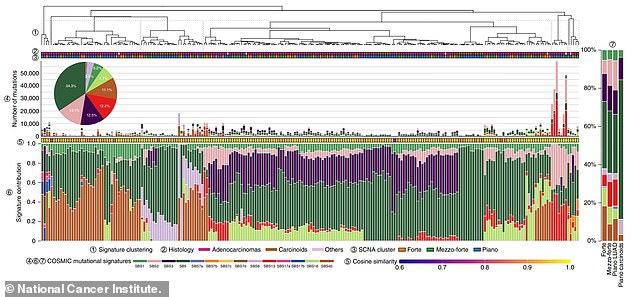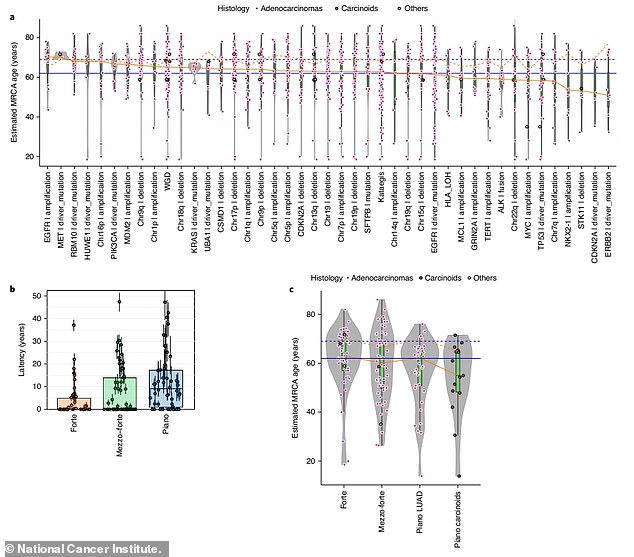Non-smokers diagnosed with lung cancer may develop the condition due to natural processes in their bodies, a new study suggests.
Researchers at the National Cancer Institute (NCI), part of the National Institutes of Health (NIH), analyzed the genetic signatures of cancer tumors in 232 never-smokers diagnosed with lung cancer – finding that these tumors were markedly different from those in smokers.
This finding contradicts past research, which had suggested non-smokers develop lung cancer after exposure to second-hand smoke or other pollutants – though the researchers say these toxins may still drive cancer development in some patients.
More research is needed to classify different lung cancer subtypes and develop treatments catering to never-smoker patients.

Non-smokers could develop lung cancer because of natural processes in their bodies, not secondhand smoke, a new study suggests

Lung cancer patients who smoked are more likely to have ‘forte’ tumors – which grow quickly – while never-smokers are more likely to have ‘piano’ tumors – which develop more slowly
Over two million people are diagnosed with lung cancer globally each year – including over 200,000 in the U.S.
This cancer causes more deaths than any other, with an estimated 1.8 million deaths globally every year.
For every 100,000 people in the U.S. about 54 new lung cancer cases are reported and 35 people die of this cancer each year, according to the Centers for Disease Control and Prevention.
Lung cancer is typically connected to smoking, but doctors are increasingly seeing cases among people who don’t smoke.
These patients now make up about 10 to 20 percent of those diagnosed with lung cancer. Non-smoker patients tend to be younger and are more often women.
Previous research has suggested that non-smokers may develop lung cancer because they’re exposed to secondhand smoke or other toxins, such as asbestos and air pollution.
But a new study – analyzing the tumors of lung cancer patients with no smoking history – finds that this cancer may in fact be a new subtype, caused by natural processes in the body.
‘What we’re seeing is that there are different subtypes of lung cancer in never smokers that have distinct molecular characteristics and evolutionary processes,’ said Dr Maria Teresa Landi, lead author on the study and an epidemiologist at the NCI’s Division Cancer Epidemiology and Genetics.
‘In the future we may be able to have different treatments based on these subtypes,’
The NCI collaborated with researchers at the National Institute of Environmental Health Sciences – also part of the NIH – and other institutions.
The study was published Monday in Nature Genetics.
The researchers analyzed the genetic makeup of tumors from 232 never-smokers diagnosed with lung cancer.
About 28 percent of the patients had been exposed to secondhand smoke, but the rest did not have known exposures to lung cancer risk factors.
NCI researchers looked for patterns called ‘mutational signatures’ – series of mutations that could indicate specific processes in the body, like exposure to a carcinogen or damage from faulty DNA.
These mutation patterns provided the researchers with clues into how the patients’ tumors developed.
Their big finding: most of the non-smoker patients had mutation patterns indicating that their cancers developed from natural body processes.
There was no indication that smoking exposure caused lung cancer, for these patients.
In fact, there was no difference in mutational signatures between the patients who did and did not have previous secondhand smoke exposure.

By looking at mutation patterns among the different tumors, the researchers found that non-smoker patients had different developmental processes compared to smokers
The researchers classified the 232 patients’ tumors into three different cancer subtypes – different versions of the condition – based on the number of genetic mutations in their tumors.
They named these subtypes with terminology borrowed from music. The ‘piano’ subtype has fewer mutations, ‘mezzo-forte’ has more, and ‘forte’ has the most.
Most smokers fall into the ‘forte’ subtype, the researchers said.
This tumor type has bigger genomic changes and grows quickly, sending a patient into later stages of their disease progression.
Non-smokers, on the other hand, tend to fit the ‘piano’ subtype with fewer mutations. This tumor type grows very slowly over the course of years or even decades.
Patients with ‘piano’ tumors had better chances of survival, the researchers found. Rapid tumor growth, common in the ‘forte’ type, is more dangerous for a patient.
But it may be difficult to identify and treat a ‘piano’ tumor because it grows so slowly.
More research is needed to identify such tumors early-on.
In their genome investigation, the researchers identified several genes that may be tied to tumor growth for the different subtypes. These genes could be used for diagnosis and treatment.

‘Forte’ tumors developed more quickly and posed more immediate danger to patients, while ‘piano’ tumors were more likely to lie dormant for years – making them difficult to diagnose
While secondhand smoke didn’t appear to cause lung cancer for the patients in this study, the researchers say it could still be a driver for other patients.
‘We need a larger sample size with detailed information on exposure to really study the impact of secondhand tobacco smoking on the development of lung cancer in never smokers,’ Dr Landi said.
Regardless, secondhand smoke is not as likely to cause lung cancer as actually inhaling smoke directly, past studies have shown.
‘We’re at the beginning of understanding how these tumors evolve,’ Dr Landi said. ‘This analysis shows that there is heterogeneity, or diversity, in lung cancers in never smokers.’
More research will take this understanding further and develop new treatments. Meanwhile, other scientists may use a similar technique – investigating the genetics of tumors – to characterize other cancers.
Source link : https://www.dailymail.co.uk/health/article-9966023/Lung-cancers-non-smokers-result-natural-processes-NIH-study-finds.html











